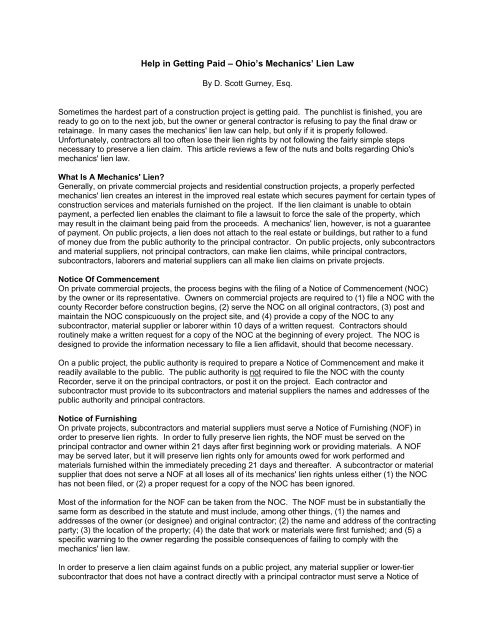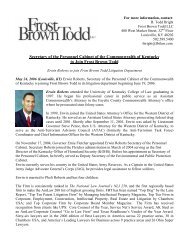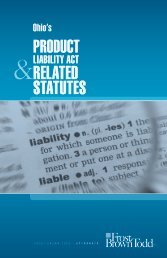Help in Getting Paid â Ohio's Mechanics' Lien Law - Frost Brown Todd
Help in Getting Paid â Ohio's Mechanics' Lien Law - Frost Brown Todd
Help in Getting Paid â Ohio's Mechanics' Lien Law - Frost Brown Todd
Create successful ePaper yourself
Turn your PDF publications into a flip-book with our unique Google optimized e-Paper software.
<strong>Help</strong> <strong>in</strong> Gett<strong>in</strong>g <strong>Paid</strong> – Ohio’s Mechanics’ <strong>Lien</strong> <strong>Law</strong><br />
By D. Scott Gurney, Esq.<br />
Sometimes the hardest part of a construction project is gett<strong>in</strong>g paid. The punchlist is f<strong>in</strong>ished, you are<br />
ready to go on to the next job, but the owner or general contractor is refus<strong>in</strong>g to pay the f<strong>in</strong>al draw or<br />
reta<strong>in</strong>age. In many cases the mechanics' lien law can help, but only if it is properly followed.<br />
Unfortunately, contractors all too often lose their lien rights by not follow<strong>in</strong>g the fairly simple steps<br />
necessary to preserve a lien claim. This article reviews a few of the nuts and bolts regard<strong>in</strong>g <strong>Ohio's</strong><br />
mechanics' lien law.<br />
What Is A <strong>Mechanics'</strong> <strong>Lien</strong>?<br />
Generally, on private commercial projects and residential construction projects, a properly perfected<br />
mechanics' lien creates an <strong>in</strong>terest <strong>in</strong> the improved real estate which secures payment for certa<strong>in</strong> types of<br />
construction services and materials furnished on the project. If the lien claimant is unable to obta<strong>in</strong><br />
payment, a perfected lien enables the claimant to file a lawsuit to force the sale of the property, which<br />
may result <strong>in</strong> the claimant be<strong>in</strong>g paid from the proceeds. A mechanics' lien, however, is not a guarantee<br />
of payment. On public projects, a lien does not attach to the real estate or build<strong>in</strong>gs, but rather to a fund<br />
of money due from the public authority to the pr<strong>in</strong>cipal contractor. On public projects, only subcontractors<br />
and material suppliers, not pr<strong>in</strong>cipal contractors, can make lien claims, while pr<strong>in</strong>cipal contractors,<br />
subcontractors, laborers and material suppliers can all make lien claims on private projects.<br />
Notice Of Commencement<br />
On private commercial projects, the process beg<strong>in</strong>s with the fil<strong>in</strong>g of a Notice of Commencement (NOC)<br />
by the owner or its representative. Owners on commercial projects are required to (1) file a NOC with the<br />
county Recorder before construction beg<strong>in</strong>s, (2) serve the NOC on all orig<strong>in</strong>al contractors, (3) post and<br />
ma<strong>in</strong>ta<strong>in</strong> the NOC conspicuously on the project site, and (4) provide a copy of the NOC to any<br />
subcontractor, material supplier or laborer with<strong>in</strong> 10 days of a written request. Contractors should<br />
rout<strong>in</strong>ely make a written request for a copy of the NOC at the beg<strong>in</strong>n<strong>in</strong>g of every project. The NOC is<br />
designed to provide the <strong>in</strong>formation necessary to file a lien affidavit, should that become necessary.<br />
On a public project, the public authority is required to prepare a Notice of Commencement and make it<br />
readily available to the public. The public authority is not required to file the NOC with the county<br />
Recorder, serve it on the pr<strong>in</strong>cipal contractors, or post it on the project. Each contractor and<br />
subcontractor must provide to its subcontractors and material suppliers the names and addresses of the<br />
public authority and pr<strong>in</strong>cipal contractors.<br />
Notice of Furnish<strong>in</strong>g<br />
On private projects, subcontractors and material suppliers must serve a Notice of Furnish<strong>in</strong>g (NOF) <strong>in</strong><br />
order to preserve lien rights. In order to fully preserve lien rights, the NOF must be served on the<br />
pr<strong>in</strong>cipal contractor and owner with<strong>in</strong> 21 days after first beg<strong>in</strong>n<strong>in</strong>g work or provid<strong>in</strong>g materials. A NOF<br />
may be served later, but it will preserve lien rights only for amounts owed for work performed and<br />
materials furnished with<strong>in</strong> the immediately preced<strong>in</strong>g 21 days and thereafter. A subcontractor or material<br />
supplier that does not serve a NOF at all loses all of its mechanics' lien rights unless either (1) the NOC<br />
has not been filed, or (2) a proper request for a copy of the NOC has been ignored.<br />
Most of the <strong>in</strong>formation for the NOF can be taken from the NOC. The NOF must be <strong>in</strong> substantially the<br />
same form as described <strong>in</strong> the statute and must <strong>in</strong>clude, among other th<strong>in</strong>gs, (1) the names and<br />
addresses of the owner (or designee) and orig<strong>in</strong>al contractor; (2) the name and address of the contract<strong>in</strong>g<br />
party; (3) the location of the property; (4) the date that work or materials were first furnished; and (5) a<br />
specific warn<strong>in</strong>g to the owner regard<strong>in</strong>g the possible consequences of fail<strong>in</strong>g to comply with the<br />
mechanics' lien law.<br />
In order to preserve a lien claim aga<strong>in</strong>st funds on a public project, any material supplier or lower-tier<br />
subcontractor that does not have a contract directly with a pr<strong>in</strong>cipal contractor must serve a Notice of
Furnish<strong>in</strong>g on the pr<strong>in</strong>cipal contractor. The same 21-day rule for commercial projects also applies to<br />
public projects.<br />
The Notice of Commencement and Notice of Furnish<strong>in</strong>g procedures apply to residential projects, except<br />
those where the owner uses or <strong>in</strong>tends to use the property as his or her personal residence and the<br />
property is a 1 or 2 family dwell<strong>in</strong>g or a condom<strong>in</strong>ium unit.<br />
Time Limits For Fil<strong>in</strong>g <strong>Lien</strong>s<br />
Assum<strong>in</strong>g you have properly served the Notice of Furnish<strong>in</strong>g, how long do you have to file a lien? On<br />
commercial projects, a mechanics' lien affidavit must be recorded with the county Recorder with<strong>in</strong> 75<br />
days from the date on which the lien claimant last worked or furnished materials. A lien affidavit must<br />
also be served on the owner of the property with<strong>in</strong> 30 days after fil<strong>in</strong>g with the county Recorder. If the<br />
owner cannot be found, a copy of the lien must be posted conspicuously on the project site.<br />
On public projects, lien claims must be filed with the public authority with<strong>in</strong> 120 days from the last day the<br />
claimant provided work or materials on the project. To obta<strong>in</strong> priority over unrecorded claims, the<br />
claimant should also file a copy of the affidavit with the county Recorder with<strong>in</strong> 30 days after fil<strong>in</strong>g with the<br />
public authority. If the claimant is a sub-subcontractor or a supplier to a subcontractor, the claimant must<br />
also serve a copy of the lien affidavit on the subcontractor with<strong>in</strong> 20 days after serv<strong>in</strong>g the affidavit on the<br />
public authority.<br />
The time period for fil<strong>in</strong>g a lien on a residential project is just 60 days from the last date the lien claimant<br />
performed labor or provided materials. However, all lien rights on a residential project are ext<strong>in</strong>guished if<br />
the owner has paid the pr<strong>in</strong>cipal contractor <strong>in</strong> full before the owner's receipt of the lien affidavit.<br />
F<strong>in</strong>al Observation<br />
Some subcontractors and material suppliers decide not to serve a Notice of Furnish<strong>in</strong>g because they<br />
worry it might "rock the boat" and cause tension with the owner or general contractor at the beg<strong>in</strong>n<strong>in</strong>g of<br />
the project. Others just do not want to add to their "paperwork". But neglect<strong>in</strong>g to preserve your lien<br />
rights can be a big mistake. Owners and general contractors generally understand and expect that a<br />
Notice of Furnish<strong>in</strong>g will be served. The bottom l<strong>in</strong>e is that if you do not preserve your lien rights, you<br />
may f<strong>in</strong>d it much harder to get paid at the end of the project.<br />
Published <strong>in</strong> The Constructor (Allied Construction Industries/AGC-C<strong>in</strong>c<strong>in</strong>nati)Scott Gurney is Chairman of the<br />
Construction <strong>Law</strong> Group of <strong>Frost</strong> <strong>Brown</strong> <strong>Todd</strong> LLC. He can be contacted at (513) 651-6841 or sgurney@fbtlaw.com.<br />
This article is presented for educational purposes. Neither the author nor <strong>Frost</strong> <strong>Brown</strong> <strong>Todd</strong> LLC, nor their present or<br />
future clients, can be bound by the op<strong>in</strong>ions, comments and <strong>in</strong>terpretations expressed here<strong>in</strong>.





